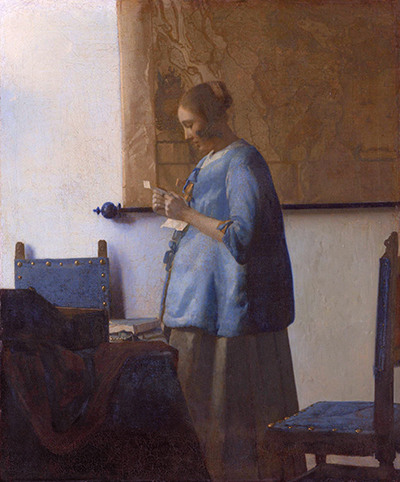Johannes Vermeer's artwork, Woman in Blue Reading a Letter, is a manifestation of the artist's exquisite realist technique with an intercut analysis to detail.
The artwork dates back to 1663-1664 to a period most prominently know as the Baroque Era during the Dutch Gold Phase.
The composition of the artwork holds the central element of the woman in blue as she is placed to the centre of the frame. The woman is standing in front of a window, while it is not exactly depicted; most of Vermeer's artwork is based in front of a window creating a much larger light source.
Based on the woman's blonde features a similar composition within her body structure, the woman seems to be the same one as in Vermeer's earlier work Girl Reading a Letter at an Open Window. Both women have the same light blonde hair that is tied up with strands of gold curls coming out of the side.
Perhaps the Woman in Blue Reading a Letter is the continuation of the original painting, Girl Reading a Letter at an Open Window. It is interesting to note that in the more recent artwork that the rounded stomach of the woman seems to showcase that the woman is now pregnant. It was highly uncommon at the time to depict pregnant woman within are yet Vermeer may have been captivated by the woman and felt the need to depict her transition within his work.
It is also significant to note that the rounded figure of the woman prevails to he fashion at the time of the composition of the work and does not showcase pregnancy. The blue dress holds elements of white at the collar of the work, paired with a blue ruffle near the front of the outfit. The bottom portion of the woman's attire transitions into a dark green under section that flares out towards the bottom.
As the woman reads the letter the viewer is left to ponder what the exact content of the paper reveal within the work. The unknown words add the element of curiosity to the work as mystery fills the canvas. Many art critics believe that based on the large map behind the woman of the Netherlands that perhaps the letter that she is reading is from a husband who is traveling.
The rounded stomach of the woman that suggests that she is pregnant adds to the idea of her husband writing to her as she awaits his arrival to begin a family. The use of a unknown letter within Vermeer's work has come to be a signature mark of the artist at it is depicted again adding curiosity to the artwork.
The composition of the painting is one that is pondered for art critics are Vermeer alters the canvas in a new direction. As evident through the work, the artist did not include a ceiling nor floor in the painting, but instead only focused on showcasing the wall.
Taking away the ceiling and floor of the room creates a flat surface throughout the painting, as there are no elements of depth. The artist is said to have used a camera obscure to aid in the composition of his work to based his artwork on a flattened view.
The blue chairs placed throughout the painting accentuate the light blue colour painted on the woman's dress. The chairs are bolted around the corners in silver bolts to hold the blue fabric down.
The artist continued the colouring by including a blue rod at the bottom of the map continuing with the blue theme showcased throughout the artwork. These colours were strategically picked by the artist to aid in the colour composition of the artwork.




